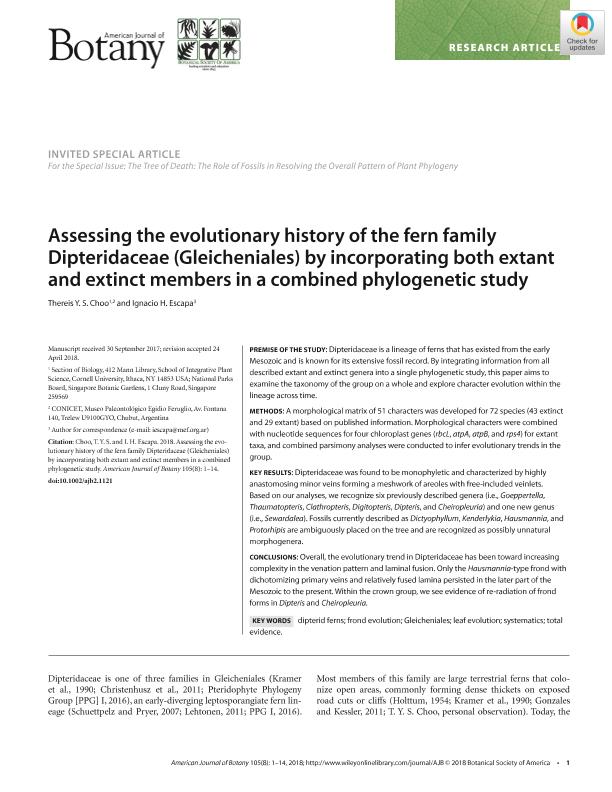Mostrar el registro sencillo del ítem
dc.contributor.author
Choo, Thereis Y. S.
dc.contributor.author
Escapa, Ignacio Hernán

dc.date.available
2020-03-06T18:04:40Z
dc.date.issued
2018-08
dc.identifier.citation
Choo, Thereis Y. S.; Escapa, Ignacio Hernán; Assessing the evolutionary history of the fern family Dipteridaceae (Gleicheniales) by incorporating both extant and extinct members in a combined phylogenetic study; Botanical Society of America; American Journal of Botany; 105; 8; 8-2018; 1315-1328
dc.identifier.issn
0002-9122
dc.identifier.uri
http://hdl.handle.net/11336/98938
dc.description.abstract
Premise of the Study: Dipteridaceae is a lineage of ferns that has existed from the early Mesozoic and is known for its extensive fossil record. By integrating information from all described extant and extinct genera into a single phylogenetic study, this paper aims to examine the taxonomy of the group on a whole and explore character evolution within the lineage across time. Methods: A morphological matrix of 51 characters was developed for 72 species (43 extinct and 29 extant) based on published information. Morphological characters were combined with nucleotide sequences for four chloroplast genes (rbcL, atpA, atpB, and rps4) for extant taxa, and combined parsimony analyses were conducted to infer evolutionary trends in the group. Key Results: Dipteridaceae was found to be monophyletic and characterized by highly anastomosing minor veins forming a meshwork of areoles with free-included veinlets. Based on our analyses, we recognize six previously described genera (i.e., Goeppertella, Thaumatopteris, Clathropteris, Digitopteris, Dipteris, and Cheiropleuria) and one new genus (i.e., Sewardalea). Fossils currently described as Dictyophyllum, Kenderlykia, Hausmannia, and Protorhipis are ambiguously placed on the tree and are recognized as possibly unnatural morphogenera. Conclusions: Overall, the evolutionary trend in Dipteridaceae has been toward increasing complexity in the venation pattern and laminal fusion. Only the Hausmannia-type frond with dichotomizing primary veins and relatively fused lamina persisted in the later part of the Mesozoic to the present. Within the crown group, we see evidence of re-radiation of frond forms in Dipteris and Cheiropleuria.
dc.format
application/pdf
dc.language.iso
eng
dc.publisher
Botanical Society of America

dc.rights
info:eu-repo/semantics/openAccess
dc.rights.uri
https://creativecommons.org/licenses/by-nc-sa/2.5/ar/
dc.subject
DIPTERID FERNS
dc.subject
FROND EVOLUTION
dc.subject
GLEICHENIALES
dc.subject
LEAF EVOLUTION
dc.subject
SYSTEMATICS
dc.subject
TOTAL EVIDENCE
dc.subject.classification
Paleontología

dc.subject.classification
Ciencias de la Tierra y relacionadas con el Medio Ambiente

dc.subject.classification
CIENCIAS NATURALES Y EXACTAS

dc.title
Assessing the evolutionary history of the fern family Dipteridaceae (Gleicheniales) by incorporating both extant and extinct members in a combined phylogenetic study
dc.type
info:eu-repo/semantics/article
dc.type
info:ar-repo/semantics/artículo
dc.type
info:eu-repo/semantics/publishedVersion
dc.date.updated
2020-03-05T14:59:17Z
dc.journal.volume
105
dc.journal.number
8
dc.journal.pagination
1315-1328
dc.journal.pais
Estados Unidos

dc.description.fil
Fil: Choo, Thereis Y. S.. Cornell University; Estados Unidos
dc.description.fil
Fil: Escapa, Ignacio Hernán. Consejo Nacional de Investigaciones Científicas y Técnicas; Argentina
dc.journal.title
American Journal of Botany

dc.relation.alternativeid
info:eu-repo/semantics/altIdentifier/doi/http://dx.doi.org/10.1002/ajb2.1121
dc.relation.alternativeid
info:eu-repo/semantics/altIdentifier/url/https://bsapubs.onlinelibrary.wiley.com/doi/full/10.1002/ajb2.1121
Archivos asociados
